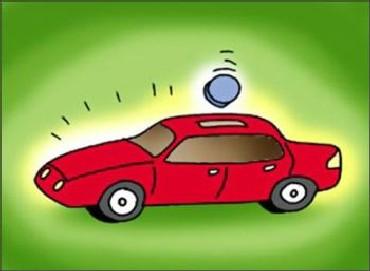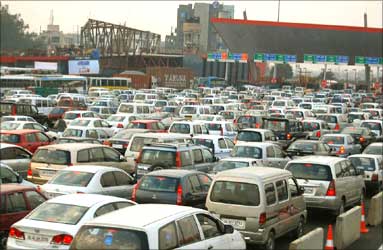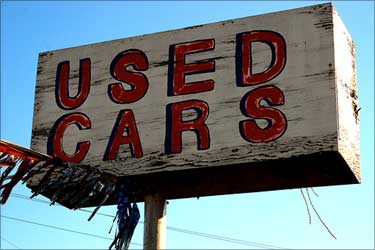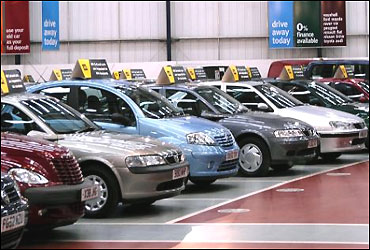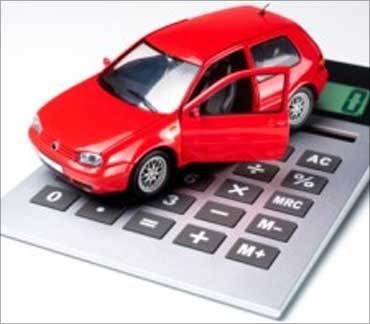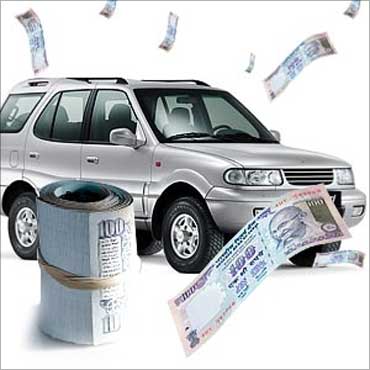 | « Back to article | Print this article |
Buying a second-hand car? Here's some GREAT advice
Is not having your set of zig wheels giving you car sickness? Also, neither do you have a bulging wallet to fulfil this wish nor do you want to take a loan to buy a car. In such a situation you can consider buying a second-hand car.
A used set of wheels is cheaper by 10-70 per cent. In fact, the moment a car rolls out of the showroom it is considered to be a used car and its value depreciates.
Therefore, it is likely that a one-year old hatchback which has been driven for about 25,000 kilometres will be cheaper by 25 per cent as compared to a new one.
Or if it's a sedan that you have been eyeing, then a three-year-old Toyota Corolla, which has been driven for 15,000 kilometres, can come cheaper by about Rs 4 lakh (Rs 400,000).
Click NEXT to read on . . .
Buying a second-hand car? Here's some GREAT advice
Lemon versus cherries
Despite the cost advantage, landing a good car deal is never easy. This is because of the 'lemon' problem.
George Akerlof explained this problem in a research paper, titled The Market for Lemons, which he wrote in 1970.
He divides the second-hand car market into two parts: peaches and lemons. Peaches are cars which are in good shape, while lemons are cars which are not in good shape.
The person selling the car knows that his car is a peach or a lemon. But the person buying the car doesn't. This phenomenon is referred to as inside information. The seller has it. The buyer doesn't.
And this is why the second-hand car market doesn't really work well.
Click NEXT to read on . . .
Buying a second-hand car? Here's some GREAT advice
As Tim Harford points out in his book, The Undercover Economist, 'Anyone who has ever tried to buy a second-hand car will appreciate that Akerlof was on to something. The market doesn't work nearly as well as it should; second-hand cars tend to be cheap and of poor quality. Sellers with good cars want to hold out for a good price, but because they cannot prove that a good car is really a peach, they cannot get that price and prefer to keep the car for themselves. You might expect that the sellers would benefit from inside information, but in fact there are no winners: smart buyers simply don't show up to play a rigged game.'
So when a prospective buyer approaches a seller, he goes with a preconceived notion that what is being sold to him is a lemon (bad car), because if it was a good car then why is being sold?
And therefore he is not ready to pay the right price, even if it is a cherry (good car). Therefore, the seller ends up withdrawing the good car from the market for lack of suitable price leading to a dearth of well-maintained cars in the second-hand market.
Click NEXT to read on . . .
Buying a second-hand car? Here's some GREAT advice
The wheel deal
But the lemon problem can be avoided by following a few steps. Before you exchange money for car keys, make sure that you are convinced that you have landed yourself a good deal. For this you need to know the basics of buying a used car.
Age and the kilometres driven are important price determinants.
Experts say that one should try and zero-in on a car which has not been driven for more than 50,000 kilometres.
However, if you are looking at buying a second-hand car only for 1-2 years and for basic usage then you can even consider a vehicle which has been run for up to 70,000 kilometres.
But anything over and above that is a clear 'avoid' because most cars have a running life of around 100,000 kilometres, beyond that they live on borrowed time.
Click NEXT to read on . . .
Buying a second-hand car? Here's some GREAT advice
Your checklist should also entail a thorough check of the car's condition. Also, try and look for a car which is feature-rich.
Apart from this, previous ownership of the car also affects the price. This means that if a car would have had been used as a taxi earlier, then its price significantly comes down.
Also, the demand for a car also affects the pricing.
A test drive accompanied by a mechanic should be a must on your list.
Watch out for obvious signs, like a fresh coat of paint. This may be to mask an accident. Also, make time for research on the car model that you have zeroed-in on and its market response so far. Find out if any defects or problems have been encountered with that particular model so far.
Click NEXT to read on . . .
Buying a second-hand car? Here's some GREAT advice
Make sure you are in possession of all the necessary documents before you take off with your new, used set of wheels.
Key documents include: copy of insurance, original car sale document, warranty cards, maintenance copies, etc.
As a seller, in order to get a good deal, you should try and furnish all required details about the car. All information about the condition, history and ownership of the vehicle should be made available to the buyer.
The right price, the right place
Earlier the options available for buying a used car were limited to the neighbourhood mechanic. But now, there are more avenues that can be explored. This helps avoid the problem as well.
Companies such as Maruti, Tata Motors, General Motors have dedicated showrooms for used cars.
Click NEXT to read on . . .
Buying a second-hand car? Here's some GREAT advice
After taking back the vehicle, they are serviced and are also put through a long checklist before being put out on sale.
Though these company showrooms may command a higher price of anywhere between 10-15 per cent, they come with some peace of mind. They are most likely to be in a better state and generally come with freebies such as three free servicings, etc.
Another option can be big car dealers. They can give you a clear picture about the condition of the car and if need arises, then can also repair and renovate it as per your demands.
However, both the seller and the buyer will have to pay a commission of up to 2 per cent.
If you are net savvy, then you can turn to online portals such as ww.crdekho.com, www.carwaale.com, www.gaadiwale.com, etc.
Click NEXT to read on . . .
Buying a second-hand car? Here's some GREAT advice
You can choose the car based on your location, model, kilometres driven, etc. These websites also help you get rid of the middlemen, which can translates into a profit of anywhere between 10-25 per cent for, both, the buyer and the seller.
It is possible that someone may offer you a slightly lower price. Don't fall for just the price until you are convinced about the condition of the car. Else instead of saving money on a second-hand car, it may turn out to be expensive!
Experts say that one should ideally not pay more than 50 per cent of the value of the car, if it is more than three years old. This amount should also cover up the expenses you will incur on servicing and renovation.
The author can be reached at shonalee.biswas@rediffmail.com
